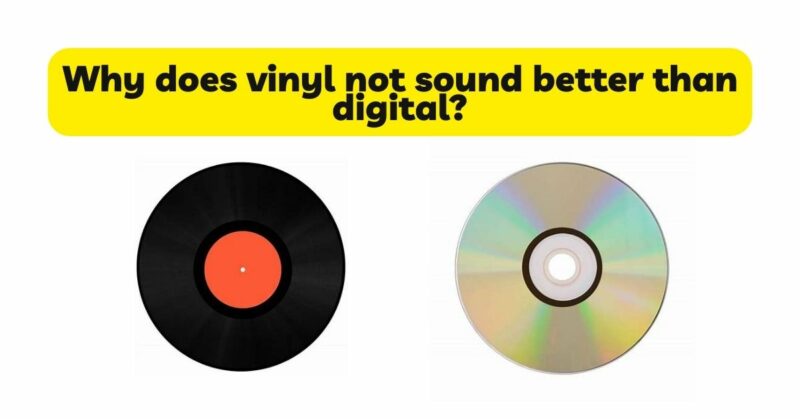Vinyl records have experienced a significant resurgence in popularity in recent years, with many enthusiasts claiming that vinyl sounds superior to digital formats. However, this belief is not without controversy, as advancements in digital audio technology have significantly improved the sound quality of digital formats. In this article, we will explore the reasons why vinyl does not always sound better than digital, including considerations of sound accuracy, fidelity, convenience, and technological advancements.
- Sound Accuracy and Fidelity: One of the key arguments against vinyl’s superiority is the issue of sound accuracy. Vinyl records are susceptible to various imperfections, such as surface noise, pops, clicks, and distortion, which can impact the fidelity and accuracy of the sound reproduction. On the other hand, digital formats, when properly encoded and decoded, can offer a more accurate representation of the original recording, without the inherent imperfections and limitations of analog playback.
- Noise and Distortion: Vinyl records inherently introduce noise and distortion into the audio signal. Surface noise, caused by dust, scratches, or wear on the record, can be audible during playback and can detract from the overall listening experience. Additionally, the mechanical nature of vinyl playback, including the stylus tracking the grooves, can introduce distortion and tracking errors that affect the accuracy of the sound. Digital formats, when played on high-quality equipment, provide a cleaner and more transparent audio signal with significantly lower levels of noise and distortion.
- Dynamic Range and Frequency Response: Vinyl records have inherent limitations in their dynamic range and frequency response. The dynamic range of vinyl is narrower compared to digital formats, which means that subtle details and soft passages may not be reproduced as faithfully. Similarly, vinyl records exhibit roll-offs in the high-frequency range, resulting in a softer and less detailed sound reproduction compared to digital formats that can accurately reproduce a wider frequency spectrum. The broader dynamic range and extended frequency response of digital formats allow for a more detailed and precise sound reproduction.
- Consistency and Variability: Vinyl records are subject to manufacturing inconsistencies and variations in sound quality. Factors such as the quality of the pressing, mastering techniques, and the condition of the record itself can significantly impact the sound reproduction. Variations in vinyl pressings can lead to different sonic experiences, making it challenging to establish a consistent and standardized quality across all vinyl records. Digital formats, on the other hand, offer consistent and uniform sound quality, ensuring a reliable and predictable listening experience.
- Technological Advancements: Digital audio technology has made tremendous strides in recent years, narrowing the gap in sound quality between vinyl and digital formats. High-resolution digital formats, such as FLAC or lossless codecs, provide greater detail, accuracy, and dynamic range than ever before. Advancements in digital-to-analog conversion technology and signal processing algorithms have significantly improved the fidelity and transparency of digital audio, challenging the notion that vinyl inherently sounds better.
- Convenience and Accessibility: Digital formats offer unparalleled convenience and accessibility. With digital music libraries, listeners have the ability to carry thousands of songs in their pockets, access streaming services with extensive catalogs, and enjoy seamless playback across multiple devices. Vinyl, on the other hand, requires physical storage space, careful handling, and dedicated playback equipment. The convenience and accessibility of digital formats make them a more practical choice for many listeners.
- Listener Preference and Subjectivity: Sound perception is highly subjective, and individual listener preferences play a significant role in determining what is perceived as better. While some listeners may prefer the warmth, character, and ritualistic experience of vinyl playback, others may prefer the accuracy, convenience, and clarity of digital formats. Listener preferences can vary based on personal taste, musical genres, listening environments, and the desired listening experience.
- 8. Quality of Equipment and System Setup: The quality of the playback equipment and system setup for both vinyl and digital formats greatly influences the sound quality. A high-quality turntable, cartridge, amplifier, and speakers are essential for achieving optimal sound reproduction with vinyl records. Similarly, using high-quality digital-to-analog converters, amplifiers, and speakers can significantly enhance the sound quality of digital formats. The proper setup and calibration of the equipment also play a crucial role in achieving the best possible sound.
- Listener Training and Experience: Listeners with extensive training and experience in audio production, engineering, or music performance may have a heightened ability to discern subtle differences in sound quality. Their familiarity with specific recordings, genres, and exposure to various audio systems over time can sharpen their perception and sensitivity to the nuances of both vinyl and digital formats. However, the general population may not possess the same level of discernment or have the trained ears required to distinguish minute differences in sound quality.
- Personal Bias and Preconceived Notions: Personal bias and preconceived notions can influence the perception of sound quality. Vinyl records carry a certain mystique and cultural significance, which may create positive biases and shape expectations of superior sound quality. Similarly, individuals who grew up with vinyl during its heyday may have nostalgic attachments that influence their preference for vinyl. It is essential to approach the comparison between vinyl and digital formats with an open mind, free from personal biases.
Conclusion: While vinyl records have their unique charm and appeal, the notion that they inherently sound better than digital formats is a subjective opinion rather than an objective fact. The accuracy, fidelity, convenience, technological advancements, and individual listener preferences all play significant roles in determining which format sounds better. Advancements in digital audio technology have bridged the gap in sound quality, allowing for highly detailed and transparent sound reproduction. Ultimately, the choice between vinyl and digital formats comes down to personal preference, convenience, and the desired listening experience of each individual listener.


